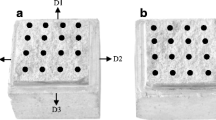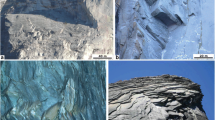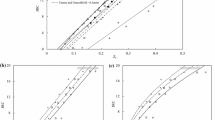Abstract
This paper deals with the structural analysis of rock fracture roughness, and accordingly, a method is developed for estimating/predicting the post-shearing 3D geometry of the fracture surface. For this purpose, surfaces of three natural rock fractures were digitized and studied before and after the direct shear test. The variogram analysis of the surfaces indicated a strong non-linear trend in the topography data. Hence, the spatial variability of the rock fracture surfaces was decomposed to: one deterministic component, characterized by a high-order polynomial representing the large-scale undulations, and one stochastic component, described by the variogram of residuals representing the small-scale roughness. Using an image-processing technique, a total of 343 damage zones with different sizes, shapes, initial roughness characteristics, local stress fields, and/or asperity strength values were spatially located and clustered. In order to characterize the overall spatial structure of the degraded zones, the concept of the ‘pseudo-zonal variogram’ was introduced. The results showed that the spatial continuity at the damage zones increases due to the asperity degradation. The increase in the variogram range is anisotropic and tends to be higher along the shearing. Consequently, the direction of maximum continuity rotates towards the shear direction. After modeling the evolution of the spatial structure with shearing and detecting boundaries of the degraded areas, a methodology was presented to provide a regression-kriging estimate of the morphology of sheared surfaces. The proposed method can be considered as a cost-free and reasonably accurate alternative to expensive techniques of scanning the rock fracture surface after the shear test.















Similar content being viewed by others
References
Amiri Hossaini K, Babanouri N, Karimi Nasab S (2014) The influence of asperity deformability on the mechanical behavior of rock joints. Int J Rock Mech Min Sci 70:154–161. doi:10.1016/j.ijrmms.2014.04.009
Asadi MS, Rasouli V, Barla G (2012) A bonded particle model simulation of shear strength and for rough rock fractures. Rock Mech Rock Eng 45:649–675
Babanouri N, Karimi Nasab S, Baghbanan A, Mohamadi H (2011) Over-consolidation effect on shear behavior of rock joints. Int J Rock Mech Min Sci 48:1283–1291
Babanouri N, Karimi Nasab S, Sarafrazi S (2013) A hybrid particle swarm optimization and multi-layer perceptron algorithm for bivariate fractal analysis of rock fractures roughness. Int J Rock Mech Min Sci 60:66–74
Barton N, Choubey V (1977) The shear strength of rock joints in theory and practice. Rock Mech 10:1–54
Beer AJ, Stead D, Coggan JS (2002) Estimation of the joint roughness coefficient (JRC) by visual comparison. Rock Mech Rock Eng 35:65–74
Belem T, Souley M, Homand F (2007) Modelling rock joint walls surface degradation during monotonic and cyclic shearing. Acta Geotech 2:227–248
Belem T, Souley M, Homand F (2009) Method for quantification of wear of sheared joint walls based on surface morphology. Rock Mech Rock Eng 42(6):883–910
Bergmann D, Galanulis K, Winter D (1997) Advanced 3d fringe projection system. GOM mbH, Braunschweig
Brown ET (1981) Rock characterization, testing and monitoring-ISRM suggested methods. Pergamon Press, Oxford
Cressie N (1985) Fitting variogram models by weighted least squares. Math Geol 17:239–252
Deutsch CV, Journel AG (1998) GSLIB geostatistical software library and user’s guide, 2nd edn. Oxford University Press, New York
Gentier S, Riss J, Archambault R, Flamand R, Hopkins D (2000) Influence of fracture geometry on the shear behavior. Int J Rock Mech Min Sci 37:161–174
Gonzalez RC, Woods RE (2008) Digital image processing. Prentice-Hall, Englewood Cliffs
Goovaerts P (1997) Geostatistics for natural resources evaluation. Oxford University Press, New York
Grasselli G (2001) Shear strength of rock joints based on quantified surface description. PhD dissertation, Swiss Institute of Technology (EPFL)
Grasselli G (2006) Manuel Rocha medal recipient shear strength of rock joints based on quantified surface description. Rock Mech Rock Eng 39:295–314
Grasselli G, Wirth J, Egger P (2002) Quantitative three-dimensional description of a rough surface and parameter evolution with shearing. Int J Rock Mech Min Sci 39:789–800
Hengl T, Heuvelink GBM, Rossiter DG (2007) About regression-kriging: from equations to case studies. Comput Geosci 33:1301–1315
Hirotaka S, Grasselli G (2010) Geostatistical downscaling of fracture surface topography accounting for local roughness. Acta Geotech 5:127–138
Journel AG, Huijbregts CJ (1978) Mining geostatistics. Academic Press, London
Kulatilake PHSW, Um J, Pan G (1997) Requirements for accurate estimation of fractal parameters for self-affine roughness profiles using the line scaling method. Rock Mech Rock Eng 30(4):181–206
Kwafniewski MA, Wang JA (1997) Surface roughness evolution and mechanical behavior of rock joints under shear. Int J Rock Mech Min Sci 34:157.e1–157.e14
Ladanyi B, Archambault G (1970) Simulation of the shear behaviour of a jointed rock mass. In: Proceedings of the 11th U.S. symposium on rock mechanics: theory and practice, Berkeley, pp 105–125
Lanaro F, Jing L, Stephansson O (1998) 3-D-laser measurements and representation of roughness of rock fractures. In: Rossmanith HP (ed) Mechanics of jointed and faulted rock. Balkema, Rotterdam, pp 185–189
Marache A, Riss J, Gentier S, Chiles JP (2002) Characterization and reconstruction of a rock fracture surface by geostatistics. Int J Numer Anal Methods 26:873–896
Odling NE (1994) Natural fracture profiles, fractal dimension and joint roughness coefficients. Rock Mech Rock Eng 27:135–153
Roko RO, Daemen JJK, Myers DE (1997) Variogram characterization of joint surface morphology and asperity deformation during shearing. Int J Rock Mech Min Sci 34:71–84
Tse R, Cruden DM (1979) Estimating joint roughness coefficients. Int J Rock Mech Min Sci Geomech Abstr 16:303–307
Unal M, Unver B (2004) Characterization of rock joint surface degradation under shear loads. Int J Rock Mech Min Sci 41:145–150
Weisstein EW (2014) Ellipse. From MathWorld—a wolfram web resource. http://mathworld.wolfram.com/Ellipse.html. Accessed 16 May 2014
Yang ZY, Lo SC, Di CC (2001) Reassessing the joint roughness coefficient (JRC) estimation using Z 2. Rock Mech Rock Eng 34:243–251
Author information
Authors and Affiliations
Corresponding author
Rights and permissions
About this article
Cite this article
Babanouri, N., Karimi Nasab, S. Modeling Spatial Structure of Rock Fracture Surfaces Before and After Shear Test: A Method for Estimating Morphology of Damaged Zones. Rock Mech Rock Eng 48, 1051–1065 (2015). https://doi.org/10.1007/s00603-014-0622-9
Received:
Accepted:
Published:
Issue Date:
DOI: https://doi.org/10.1007/s00603-014-0622-9




